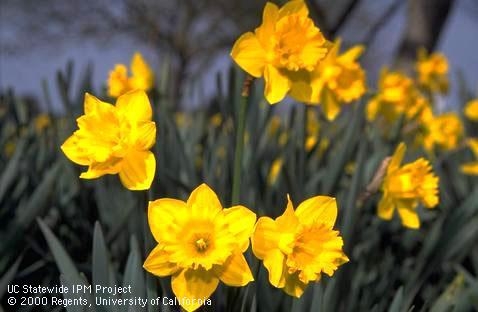It is time to order spring-blooming bulbs from the many catalogs that may be turning up in our mailboxes. Daffodils are perhaps the easiest bulbs to depend upon for a colorful display that can last for several months, if you choose varieties carefully.

For outdoor display, daffodils should be planted in the fall, between September and December (November is perhaps the best time). Select high-quality bulbs that have not dried out. Generally, the larger the bulb, the better. Plant in full sun or part shade. Daffodils tolerate a range of soils but grow best in moderately fertile, well-drained soil that is moist during the growing season. They prefer neutral to acidic soils.
Daffodils are most effective if planted in groups of ten or more of a single type. Pay attention to bloom times and plant heights if you are planting different varieties in the same area. Bury bulbs with their pointy ends up, two to three times as deep as the bulb is tall, spacing them three to six inches apart. To prevent bulb rot, avoid watering in warm fall weather, but do water them for two to three weeks after they have bloomed if the weather is dry.
Over time, daffodils that have naturalized will become crowded and will bloom less. Apply a low-nitrogen, high-potassium fertilizer after flowering if bulbs are not performing as well as expected (or as well as in previous years). Lift and divide the clumps when they become over-crowded and/or flowering becomes sparse. Plants can actually be divided and transplanted when they are flowering, which can help you place them for best effect over the years.
After bloom, allow the plants to grow until the leaves die back (in May or June) so the bulbs can store energy for next year. Let dead leaves decompose in place or remove them by twisting and pulling lightly, to avoid pulling up the bulbs.
Daffodils are both deer-resistant and rodent-proof but are poisonous to pets. Common pest problems include large narcissus bulb fly, bulb scale mite, narcissus nematode, slugs, narcissus basal rot, and a number of viruses.
Here is a suggested list of four varieties for continuous daffodil flowering from late January to April. Each is a naturalizing variety, so they will increase and continue to bloom in succeeding years if left in the ground.
- “King Alfred,” a large, trumpet type that blooms early to mid-spring, with one flower per stem, 13 to 18 inches tall. Others of this type are “Dutch Master,” “Golden Harvest,” and “Marieke.”
- “Jetfire,” a cyclamineus type with a bright orange cup that blooms early to mid-spring, with one flower per stem, 13 to 18 inches tall. Performs wonderfully in pots; terrific for forcing; more tolerant of partial shade and moisture than other groups.
- “Quail,” a jonquilla type, blooms mid- to late spring, has two to three highly fragrant flowers per stem, grows 12 to 18 inches tall. Good choice for containers, rock gardens and dainty spring bouquets.
- “Geranium,” a tazetta type, blooms mid- to late spring, has up to six flowers per stem, grows 13 to 18 inches tall.
The sight of daffodils blooming on a spring day can pay dividends long after their bloom has past – William Wordsworth certainly found this to be true, as demonstrated by one of his best-loved poems:
I Wandered Lonely as a Cloud
By William Wordsworth
I wandered lonely as a cloud
That floats on high o'er vales and hills,
When all at once I saw a crowd,
A host, of golden daffodils;
Beside the lake, beneath the trees,
Fluttering and dancing in the breeze.
Continuous as the stars that shine
And twinkle on the milky way,
They stretched in never-ending line
Along the margin of a bay:
Ten thousand saw I at a glance,
Tossing their heads in sprightly dance.
The waves beside them danced; but they
Out-did the sparkling waves in glee:
A poet could not but be gay,
In such a jocund company:
I gazed—and gazed—but little thought
What wealth the show to me had brought:
For oft, when on my couch I lie
In vacant or in pensive mood,
They flash upon that inward eye
Which is the bliss of solitude;
And then my heart with pleasure fills,
And dances with the daffodils.
The Master Gardeners' Fall Workshop Series begins on Monday, August 28th with the first of a two-parter on home canning and preserving. All workshops are free, but they do require advance registration. For descriptions of all sixteen workshops and to register, visit our website.
UC Master Gardeners of Butte County are part of the University of California Cooperative Extension (UCCE) system. To learn more about us and our upcoming events, and for help with gardening in our area visit our website. If you have a gardening question or problem, email the Hotline at mgbutte@ucanr.edu or leave a phone message on our Hotline at 530-552-5812. To speak to a Master Gardener about a gardening issue, or to drop by the MG office during Hotline hours, see the most current information on our Ask Us section of our website.